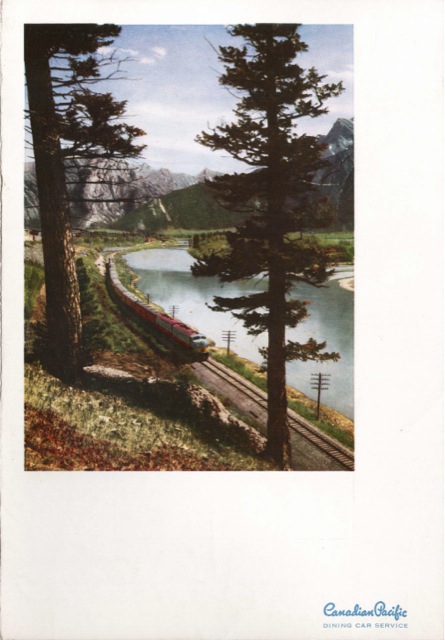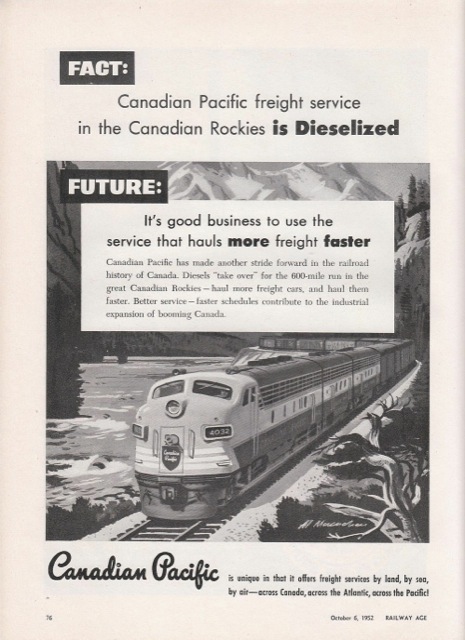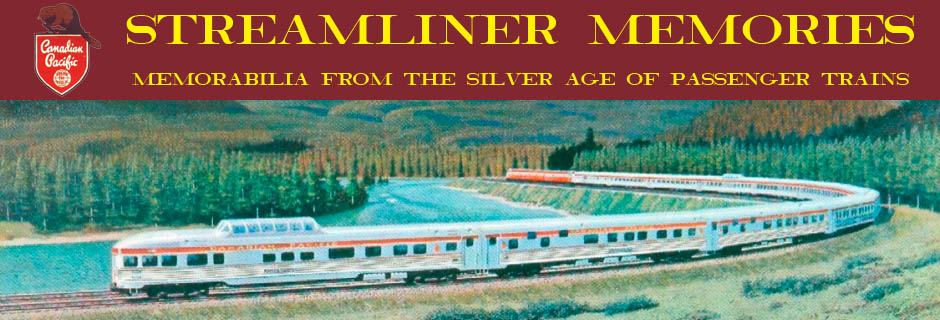Canadian Pacific proudly put a Diesel-powered Dominion on the cover of this 1953 menu, finally conceding that Diesels would soon completely replace steam. Diesels were “the latest contribution to the ease and comfort of passengers,” said the back cover of the menu.
 Click image to download a 1.5-MB PDF of this menu.
Click image to download a 1.5-MB PDF of this menu.
Yet Canadian railways were sadly well behind railways in the United States. Some, including the Rock Island, Southern, and Western Pacific, retired their last steam locomotives in 1953, and most others weren’t far behind.
It’s easy to make fun of Canadian Pacific’s slowness to adopt this new technology. After all, Canada’s incomes were somewhat lower than those of the United States, so it might be expected to be a bit behind. In fact, the railroad had no good excuse except for the prejudice of its head of motive power, Henry Blaine Bowen, who made the railway’s locomotive purchase decisions from 1928 through 1949–which, not by coincidence, was the year it purchased its last steam locomotive.
Admittedly, CP purchased its first Diesel, a box cab that it used as a switch engine, in 1937. Still, this was well over a decade after U.S. railroads had begun experimenting with similar “oil electrics.”
At the time CP ordered this Diesel, Bowen went on the record to say, “The diesel engine of today, as wonderful as it is, is doubtful as a lasting standard and it seems a reasonable prediction that it will be considered obsolete in a short period of years.” In a sense, he was right: the box cabs of 1937 were rendered obsolete by the General Motors Diesels of 1939, which in turn were rendered obsolete by later Diesels. But, since around 1960 to this day, Diesel-electrics have ruled North American rails almost everywhere except a few places that still have overhead wires.
 Click image for a larger view.
Click image for a larger view.
After Bowen retired, the railroad picked up the pace of Dieselization, powering much of its freight service with Diesels by 1952, as shown in the above ad. But this was well over a decade after many American railroads, including the Great Northern and Santa Fe, had already done so. Among class I railroads in the United States, only Norfolk & Western held out for steam longer than the Canadian roads, and then only because it had access to so much cheap coal.
In any case, the menu inside offers the usual range of Canadian Pacific fare, including seven table d’hôte entrées and around a dozen a la carte entrees. Prices are much higher than just a few years before, however. Whereas CP’a 1941 menu offered table d’hôte dinners for $1.00 and $1.25 ($1.75 to $2.20 in 1953 dollars), the 1953 menu asks as much as $4.75 for a sirloin steak dinner, and $3 for the steak by itself that cost only $1 ($1.75) in 1941.

I note the menu talks of diesel-electrics with 1500 and 1600 horsepower. The 1500 HP units must have been F-7’s while the 1600 HP units were apparently MLW FPA-2’s, since they were the only passenger cab units with 1600 HP.
I see sardines sandwiches have showed up again on this menu. At least there’s no tongue or sweetbreads. Apparently the “Red Brand” steaks were well known in Canada and commanded a premium price. $3.00 seems like a lot for a small sirloin steak. I think all those prices are in Canadian dollars though. However, the Canadian dollar was only two cents less than the US dollar in 1953 as the Canadian dollar was near an all time high in that year. Even in Canadian dollars, that was an expensive menu for 1953.
Jim